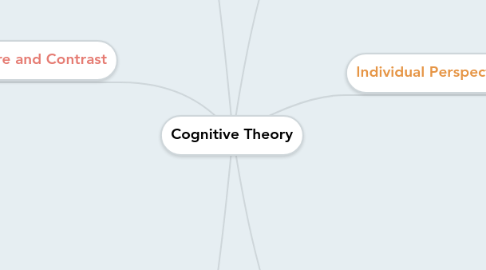Cognitive Theory
作者:Sade Khamassi

1. Vygotsky's Theory
1.1. Social Development Theory
1.2. Social interaction
1.3. Community is central in the process of "making meaning"
2. Compare and Contrast
2.1. Differences
2.1.1. Vygotsky (Ormrod, p.37-41).
2.1.2. Culture shapes development
2.1.3. Social factors are influential
2.1.4. Language and thought are separate. Language is internal
2.1.5. Adults are the forefront of development
2.1.6. discovery occurs with assistance from society
2.1.7. Zone of proximal development
2.1.8. Piaget (Ormrod, p 26-34).
2.1.9. Universal stages
2.1.10. underestimate social environment as a factor
2.1.11. thought proceeds language
2.1.12. peers play an important role
2.1.13. self initiated discovery
2.2. Similarities
2.3. young children are actively learning and discovering
2.4. Constructivists
2.5. society sets the limits of development
2.6. Guided teaching is needed
3. 21st Century (Applying theories to today)
3.1. The scaffolding approach is still a great way for teachers to approach lessons for students
3.2. We are currently learning how a child's cultural can directly effect how the child relates to classwork and success of that student, which directly relates to Vygotsky's theory of culture shaping development
3.3. Teachers/adults are at the forefront of development especially in the classroom setting, where they are still required to continue the development process
3.4. Piaget's thoughts on peer influence can be argued that in classrooms, students development immensely from peer interaction
4. Piaget's Theory
4.1. Developmental Stage Theory
4.2. Children construct understand through experience and discovery (Ormrod, p. 27).
4.3. Child centered classrooms with "open education"
5. Individual Perspective
5.1. Vygotsky's theory of social development makes the most sense to me
5.2. I believe that the culture and social environment plays an immediate role in development
5.3. The way we see the world is directly effected by how we grow up and the community we grow up in
5.4. the ZPD (Zone of Proximal Development) without prior knowledge, there is no way to solve problems (Ormrod, p. 39).
5.5. Vygotsky's theory concerning language with private speech and social speech (Ormrod, p. 38).
6. Application for Education using Vygotsky's theory
6.1. using hits to help children understand the basis of instructional activity known as "guided practice"
6.2. dividing groups of children at different levels to help each other learn
6.3. Scaffolding to help instruct but bridge gap between learning and performing independently
6.4. Example: A child might be presented with a rattle when learning new words. The child shakes the rattle for each sound in the word, until the child no longer needs to shake the rattle to complete the word. The teach provides the tool to help facilitate learning, but the child must move from the assistance to learning the word on their own unassisted.


